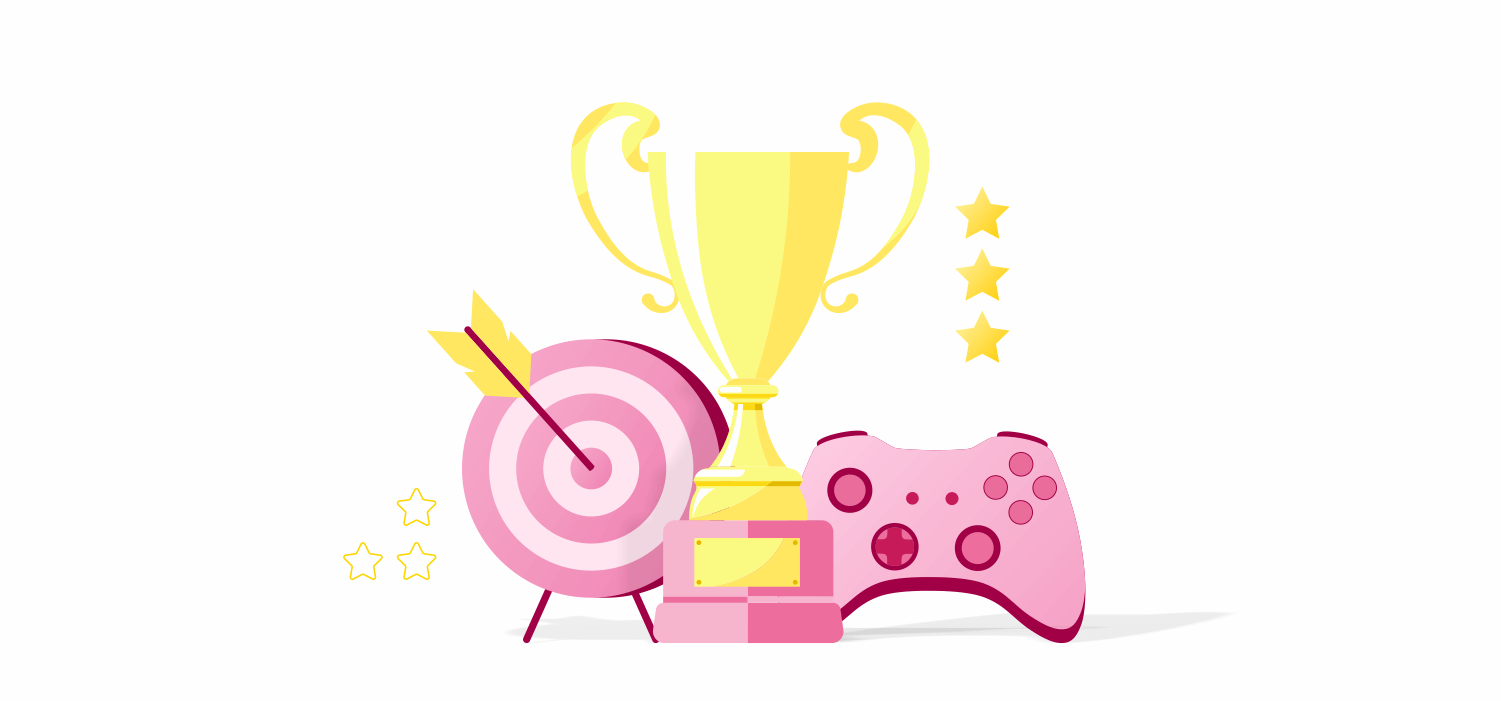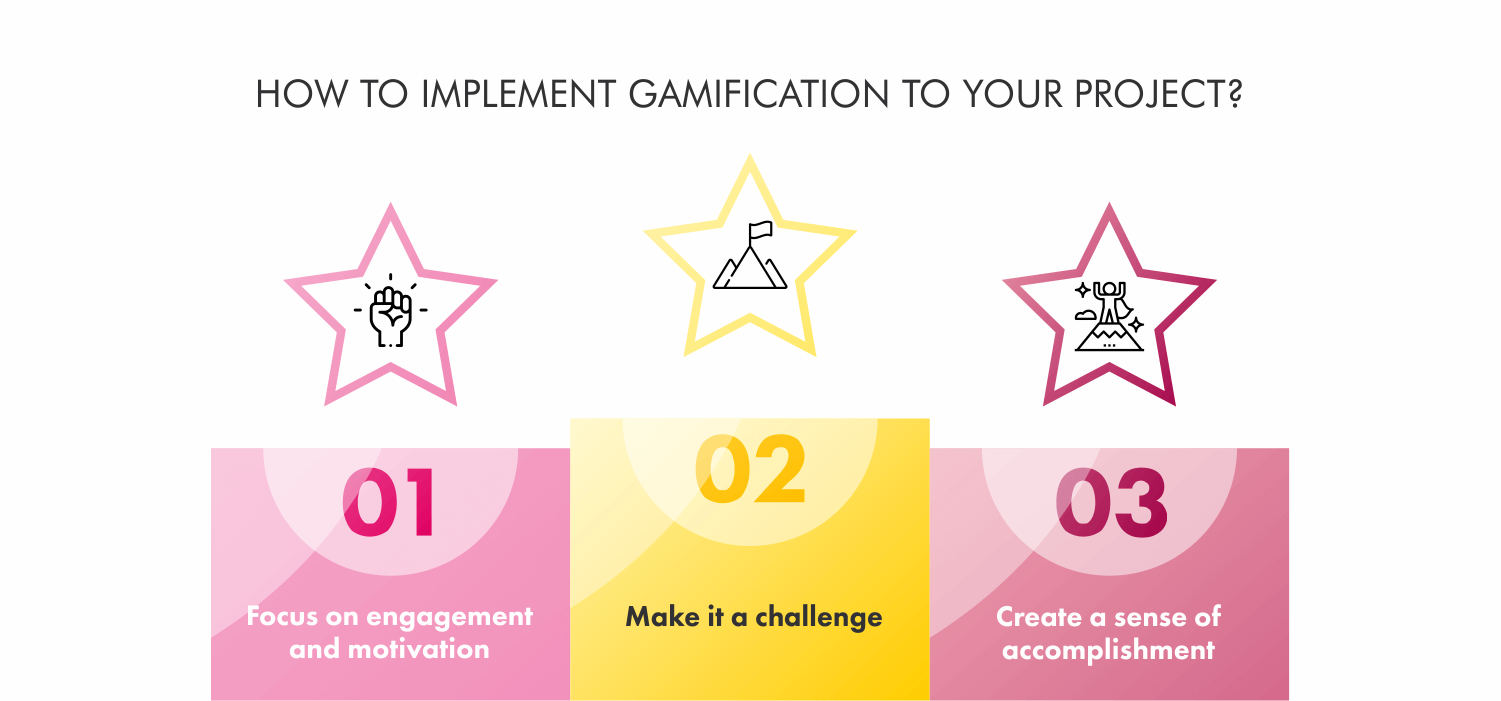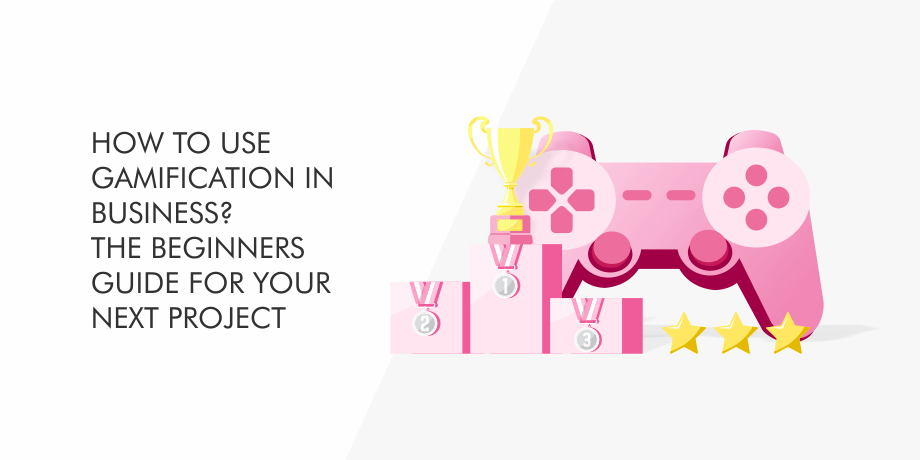We all love games.
The reason for that is quite simple.
Games are fun and mentally stimulating.
Moreover, gamification in business is a great strategy to build an engaging product and boost brand awareness. But how to use gamification in business processes? The greatest thing about the gamification strategy is that it is very easy to implement and it will be a valuable supplement in each and every niche market. Our team will explain the main gamification tactics, tools, and reason to use gamification elements in your next project.
So, without further ado, let’s the game begin.

How to Use Gamification in Your Business?
So, what is the definition of gamification? It’s a common practice to suggest that it is playing games. In reality, gamification a bit broader concept. It is the idea of applying gamification techniques and game design techniques to engage and motivate people to achieve their goals. Gamification taps into the basic desires and needs of the user’s impulses which revolve around the idea of status and achievement.
Gamification in business is more about the strategy you should implement so your content could be more enjoyable and easy to consume. Nowadays, a lot of companies and successful startups begin the gamifying processes to better appeal to consumers and increase customer retention.
Read our article “Using Gamification in Your Startup: Examples of Leading Apps and Our Experience”
For example, the application of typical elements of game playing to other areas of activity is a great online marketing technique to encourage engagements with a product or service. As a result, gamification is touted as the next-generation method for marketing and customer engagement in popular discussion. Basically, gamification became a business tool representing a whole new direction for achieving goals you have set for your small business.
What are Gamification Tools?
Gamification is fairly easy to implement in your business. Plus, you can choose from a wide variety of approaches to make sure they mesh with your content. Check out the following gamification techniques that you can use in your project: leaderboards, quizzes, badges, leveling, challenges, progress bar, actual games.
Leaderboards
From time to time we’re all guilty at the desire to compete with others and what is more important outperform someone to be on top. Leaderboards have long been a way of achieving status in the gaming world. One method we’ve found to be effective at boosting engagement is having a leaderboard around your content.
For example, you can create a message board where your online community will be able to communicate and exchange some pieces of advice. Building a leaderboard that will rank each member by the number of their comments, replies, and other elements. Therefore, if someone was in the sixth position, this could motivate him to keep engaging further to achieve the top three.
Leaderboards can take many shapes and forms. It depends on your creativity. For instance, you can use a simple leaderboard approach for featuring your blog articles to show users what articles are most popular and encouraging them to click through and read the most popular ones.
Quizzes
Let’s face it, who doesn’t like to solve riddles and quizzes. We like to unearth information about ourselves, figure out who we are and what we value, and often share it with others. Quizzes cater to this narcissistic tendency and can be highly effective at reeling in your audience. The best part is that many people will want to get their friends involved, which translates into more traffic.
Whenever you’re creating content, see if you can incorporate a quiz to encourage audience participation. They are fairly easy to design while the traffic could increase significantly. There is no surprise that some of the most popular quizzes come from BuzzFeed. The main reason for this is the fact that quizzes appealing to people. You may be busy, stressed, and have a ton of things on your schedule for today. But a quiz about “name the states’ capitals” is somehow recharged you, so you want to play. Why? Because there is a subtle challenge to your smartness. You want to prove—whether to yourself or to others—that you’re good at knowing capitals. So, you take the quiz.
Badges and Leveling
People also like to be rewarded for their efforts. Giving audiences virtual badges has become a popular way to reward people for the time and energy they invest. These badges tend to make people feel legitimized, and users can show them off to their friends.
If you were trying to encourage readers to comment on your blog posts, you could give readers certain badges for the number of comments they left or for the length of time they contributed to a discussion.
Leveling is similar to badges because it exploits people’s desire to achieve a certain status. But rather than using digital icons as rewards, you assign your customers, readers, etc. different levels according to their level of involvement.
Challenges
Gamification features without the challenge element will be quite boring. Testing ourselves pushes us to grow, progress, and become better versions of ourselves.
You could challenge consumers to post pictures on Instagram showing unconventional ways of using your product. Or maybe at the end of a blog post, you create a scenario and ask your readers a question to see what they would do in a difficult situation. Many people will be compelled to take you up on a challenge, and you’re likely to see a significant increase in engagement.
Progress bar
Perhaps one of the most straightforward gamification techniques is to simply display a progress bar as a person completes a form or reviews a product/service. This shows people what percentage of the process they’ve completed as they move from step to step.
You can use progress bars almost anywhere. People hate to leave things incomplete, so the desire to complete a process can serve as motivation to follow through to the end.
Actual games
You can add actual games even if the game doesn’t have much to do with your content or product, it will still keep people engaged with your site. As we mentioned at the beginning people love games, so why not try to incorporate this into your business.
The easiest way to include actual games into your content is to add a game to your 404 pages. Therefore, instead of “something went wrong” there will be an interactive game. For example, Google is known for this tactic. In addition, you can include small games into your blog instead of the actual article. For readers, it will be quite unexpected and new to learn something new from this game.

What to gemify in your business?
We sum up the information above and came up with three main tips about how you can implement gamification to your project.
#1 Focus on engagement and motivation
Think of your learners like players on a journey from novice to master. This is what makes games engaging — and sometimes addictive. Build your online learning in a way that encourages learners to strive to reach the next stage.
Here are some ideas that work well:
Present a series of small, achievable challenges to reach an overall goal.
Use quests to engage and motivate. Start with a simple question or quiz.
Give learners the opportunity to learn from their mistakes. Provide great feedback that shows learners where they went wrong and gives them a chance to try again, keeping them motivated to continue learning.
Use film and audio to provide interaction.
#2 Make it a challenge
Lots of small, incremental challenges maintain the motivation to improve skills and knowledge. Make challenges achievable and provide feedback and branching navigation to keep the course relevant and engaging.
Here's an example where a game that makes learning a challenge. The interactive historical game Medieval Swansea enables learners to take on the role of a detective to solve a mystery. Learners complete challenges to unlock stages. Some of the successful gamification features include:
Scenario learning: learners complete interactive challenges and quests.
Storytelling: narrates the different stages.
Progression: a dynamic map shows players/learners what stage they are at and what’s left to complete.
Dynamic polling: players vote on solving the mystery and see what other players are saying.
Challenging: there are opportunities to gather points and bonuses that unlock future stages.
#3 Create a sense of accomplishment
Affirm learners’ progress with tests and scores. Once learners pass a test or a level, give them something to show they’ve done well. Badges can be awarded to learners who have successfully completed stages in a program. Achievement rewards can also be used to unlock levels in your course, or they can be used in compliance training to demonstrate the workforce’s competence in a particular area.
Pros and cons of gamification in business
As any business strategy gamification has its benefits and drawbacks.
Advantages:
Boost a user engagement: Gamification can transfrom boring content into an exciting game. Depending of the niche market there is an opportunity to make content educational.
Provide feedback from the user: Games allow users to provide valuable feedbacks about the quality of the product.
Increase motivation: Through rewards and the entertaining content user motivation is increased to continue use your app.
Disadvantages:
Cost and resources: The development cost is not cheap, plus, the time to develop a gamified apps will take some time. It will depends of how complex the gamification idea and the product.
Highly competitive: Gamification is a huge trend right now, so this niche is highly competitive. There is no point to copy the games from the popular brands. Instead of it, think how you can combine your content and games together to create a valuable user experience.

Why Does Gamification Work?
Let’s talk about what makes gamification so attractive to all the users? Probably due to the fact, it triggers emotions that are linked to positive user experience. For example:
It gives the user control
Simple psychology tells that people don’t like to be ruled but rather choose their own path and destination. They like to be masters of their own destiny. Most people like to feel in control of the situation. So, it relates to the gamification processes.
The core of gamification is a “choose-your-own-adventure” book or picking which level to play in a game. Online courses do this very well, like Codeacademy or Udemy. Their gamified system puts the user in control at all times. You can pick the lectures (laid out like levels) and you’re in control of clicking “next lecture” whenever you want. It's a simple trick, but get a kick out of making our own decisions.
Maps frame the sense of direction
There is a reason why World of Warcraft or Mario have maps. One again it is simple psychology when people would like to know where are they heading. You can take this mapping system and apply it to different aspects of your own app or website. Something as simple as a progress bar acts like a map for your users. They know where they are in the process. They know how far they’ve got to go. If you can include milestones of achievement along the way. Such a move will break up the journey and makes it seem more manageable.
A sense of achievement
Achievement is one of the most powerful psychological driving factors of human behavior. In fact, everything we do, we do to achieve something like learning new skills, managing money or getting fit. If you can make your users feel like they’ve achieved something, they are going to come back. Even simple “well done!” when a user completes a task helps a milestone and create a sense of completing a level.
Set goals and complete with ourselves
Competitive by nature, people get a certain level of satisfaction when they compete with others and push their boundaries further and harder. “Personal bests” and “previous records” are excellent triggers to make your users come back and try again. Show us our own statistics works as a great motivation to do better the next time.
Compete with others
All social media platforms a great at the gamified competition. The only question Who can get more likes/subscribers/followers? Motivates to post more and better content than your competitors. It’s all one big game, where everyone is a player. So, any website that makes use of leaderboards and top scores instantly triggers that natural instinct to compete.
Teamwork and community
People are social animals. That is why multi-player games are so popular. If you can make users feel like part of a team or community on their journey, you’ll create loyalty and positive user experience.
Exploring and escapism
The whole reason we love video games is for their escapism. Getting lost in roleplaying worlds and exploring an altered state is why games like Final Fantasy and World Warcraft are so popular today. When you give your users the freedom to explore, it creates intrigue and excitement. Two very powerful emotions. And a positive user experience. Of course, this exploration should be carefully structured so users don’t get lost.
Rewards are appealing
Psychological reward from social media platforms is likes and followers. So you tend to post more and more pictures/blog posts. Reward online is great, but why not to make it a physical one, too. For example, Starbuck or Caffe Nero offer rewards after a certain number of purchases - like the free cup of coffee. Such tactics work great among the consumers since everyone is eager to get a free cup of coffee.
Dopamine and addiction
Gamification triggers a dopamine rush. It’s that simple. Leveling up, gaining a reward, getting feedback or achieving something all gives you that little rush. That’s dopamine in your brain. It’s your mind telling you to do it again because it feels good. There’s a reason we get addicted to gaming. And there’s a reason why websites and apps that harness gamification retain their users. You keep coming back for that dopamine hit.
Conclusion
The practice of engaging people for business through games is not new. Nevertheless, it’s a great strategy to use in your new small business since it will help you to build an engaging product and boost brand awareness. The gamification elements are fairly easy to implement in your small business. Precisely, you need to focus on engagement and motivation, make it a challenge, create a sense of accomplishment. Gamification provides positive effects, however, the effects are greatly dependent on the context in which gamification is being implemented.
We hope that you will find this article useful in your future career endeavors. In case you still have any questions or suggestions feel free to contact us and we gladly assist you in any inquiries.





